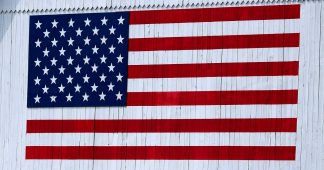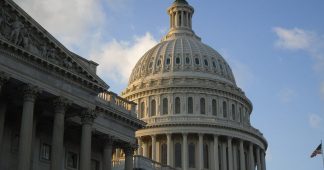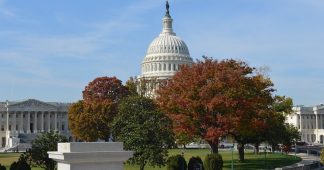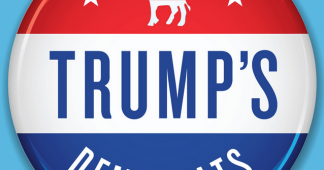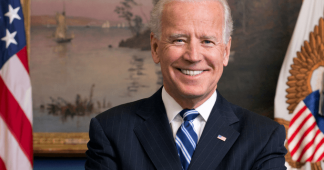The storming of the U.S. Capitol on January 6th was an expression of political resentment, a deep-seated rage that spoke to grievances that involved far more than Donald Trump and the outcome of 2020 presidential election. It is Biden’s – and America’s – gravest challenge.
The attack raises important questions about race, class and the future of U.S. political parties. Over the last half-century, white voters have shifted from moderate Democrats to conservative (and often racialist) Republicans. One factor that played into white – and especially working-class — dissatisfaction with the Democrats is a deep sense of resentment. As Sherry Linkon insightfully observed, “Resentment is a cultural response to economic struggle.” And she adds, “It festered as people read national media stories about how deindustrialization was part of a process of ‘creative destruction’ that would revitalize the economy.”
Without addressing the deep sense of resentment of white Americans that appears to have contributed to the Capitol attack – let alone Donald Trump’s 2016 election victory and the 70-odd million people who voted for him in 2020 – the growing rightwing turn of the Republican Party will only further polarize U.S. politics.
***
The historian Steve Fraser formulated the current political situation in very vivid terms: “The limousine liberal and the silent majority are emblems of class struggle American-style. The first is an epithet, the second an invocation.”
According to Fraser, the defining “limousine liberal” was derisively identified as the former New York mayor, John Lindsay; Richard Nixon first labelled the great body of white Americans as “the silent majority.” Ironically, both terms came into use during 1969, a pivotal year of a tumultuous era.
The Great Depression and World War II forged the old value system of self-denial that was superseded by the post-Cold War consumer revolution. As Americans abandoned the older ideal of self-denial for consumerism and moved to the suburbs, they took on debt for private housing, cars and education, and, increasingly, shifted to white-collar and service jobs. Union membership eroded.
In the ‘60s, many Americans began to embrace a new, personal value system, one that saw increasing numbers of women in higher education and in the workforce. And the old taboos about premarital sex (including among adolescents), the right to birth control and abortion, and gay visibility – along with rock-&-roll — changed the cultural landscape.
In reaction, the ‘70s saw the birth of a profound counter-revolution drawing together the conservative business elite, evangelical Christians and white racialists. This powerful force helped secure Nixon’s second term as president. Nixon implemented a bold theory proposed by Kevin Phillips in 1969, dubbed the “Southern strategy,” that reconfigured national politics and shaped the culture wars for the next half-century.
The Southern strategy was designed to supersede the New Deal vision that anchored the white working-class and poor to the Democrats Party. It recognized that two developments reshaped the political landscape. First, the old – and especially white – industrial working class was in decline as a relative proportion of working people. Second, mounting racial tensions precipitated 1,949 civil disturbances between May 1968 to December 1972 — what Elizabeth Hinton, in America on Fire, calls “rebellions” — offered the Republican right an invaluable opportunity to reconfigure political alignment along racial lines not only in the South but throughout the country.
The political realignment of the white working-class and poor took shape under Nixon. Pres. Lyndon Johnson sought to extend the old New Deal coalition with the “Great Society,” based on a coalition with Negro/Black voters, strengthened the Republican racialist strategy. Pres. Jimmy Carter, even though he was a Southern evangelical, couldn’t hold onto white voters, especially as “stagflation” — high inflation and slow economic growth – undercut his presidency. Pres. Ronald Reagan drew what were identified as “Reagan Democrats” into the Republican Party.
The final turn of a sizable sector of white voters to the Republican Party took place under Pres. Bill Clinton. Together with the Democratic Leadership Council, he forged the current neo-liberal, corporate capitalist political system. He embraced big capital and globalization while jettisoning the white working-class and poor. Lawrence Summers, Clinton’s Treasury Secretary, defined the structure of the rebranded Democratic Party as a “coalition of cosmopolitan elite and diversity.”
Since Clinton, the Democratic Party has becoming increasingly frozen as it sought to contain the two extremes of “elite and diversity.” As was reported, in the 1960s, Congressional districts in the bottom 40 percent of income were far more likely to vote Democratic. However, “… by 2010 the lines had crossed … and the ten richest congressional districts in the country, and 44 of the richest 50, are represented by Democrats.”
Further insight into deepening racial resentment is graphically outlined by DataWrapper that details voting patterns of noncollege educated white voters between 1980 and 2016. In 1980, the white share of the voting population was 63 percent and Republicans captured 57 percent of the vote; by 2000, the white share had fallen to 46 percent and the Republican share held at 57 percent; however, by 2016, the white share had fallen to 34 percent, but the Republican share jumped to 67 percent. The Brookings Institute, analyzing CNN data for the 2016 and 2020 elections, found that “… what is especially noteworthy is the decline in Republican support in a key Trump base: white men without college educations. This group showed a reduced Republican advantage between 2016 and 2020, from 48% to 37%.”
***
The white voters that backed Trump and the Republicans in 2016 and 2020 are suffering and are deeply resentful. And without addressing this condition, their lives – and U.S. politics – are likely to only get worse.
Shortly after the 2016 election, Shannon Monnat published a revealing study, “Deaths of Despair and Support for Trump in the 2016 Presidential Election.” Her analysis is pretty straight forward:
Much of the relationship between mortality and Trump’s performance is explained by economic factors; counties with higher economic distress and larger working-class presence also have higher mortality rates and came out strongly for Trump.
She adds, “In many of the counties where Trump did the best, economic precarity has been building and social and family networks have been breaking down for several decade.”
Monnat details how Trump performed best in counties with high economic distress and a large white working-class and poor, counties with the highest drug, alcohol and suicide mortality rates. She notes, “many of the counties with high mortality rates where Trump did the best have experienced significant employment losses in manufacturing over the past several decades.”
Monnat concludes on a cautionary note: “Clearly there is an association between drug, alcohol and suicide mortality and Trump’s [2016] election performance.” But she warns, “However, this relationship should not be interpreted as causal. No single factor (including race, education, income, rurality, or health) can explain this election outcome.” A comparable study of Trump voters in 2020 may well reveal a more distressing condition.
In 2017, two Princeton economists, Anne Case and Angus Deaton (a Nobel Prize winner), released a revealing, if scary, study, “Mortality and Morbidity in the 21st Century.” Their findings are alarming:
We find that mortality and morbidity among white non-Hispanic [WNH] Americans in midlife since the turn of the century continued to climb through 2015. Additional increases in drug overdoses, suicides, and alcohol-related liver mortality — particularly among those with a high school degree or less — are responsible for an overall increase in all-cause mortality among whites.
They persuasively argue that this developed is “triggered by progressively worsening labor market opportunities at the time of entry for whites with low levels of education.” Under the coronavirus pandemic, this situation has only gotten worse.
While most Americans are fearful of cancer and heart disease, the scholars note that declines in these conditions have been offset by “increases in drug overdoses, suicides, and alcohol-related liver mortality in this period.” Case and Deaton identify this growing condition as “deaths of despair” and it is leading to increased mortality among middle-aged WNH men and women. Sadly, many of these people were likely Trump supporters.
Poverty plays a critical role in white – and especially working-class — resentment. In 2019, 39.4 million Americans were identified as being poor – 12.3 percent of the population. In 2020, as Covid-19 and the recession take their toll, the number of poor people and those just getting by will likely increase significantly.
But numbers can be deceptive. Looking at the poverty rate in term of percentages paints one picture. In the U.S., only 9 percent of White Americans were identified as poor while 21 percent of Black, 17 percent of Hispanic, 24 precent of American Indian/Alaskan Native, 10 percent of Asian/Native Hawaiian and Pacific Islander, and 15 percent of Multiple Race Americans were identified as poor.
However, shifting from percentage to actually numbers tells a different — and more alarming — story. In 2019, 17.3 million whites were poor compared to 8.4 million Blacks, 10.2 Hispanics, about a half-million American Indian/ Alaskan Native, 1.8 million Asian/Native Hawaiian and Pacific Islander, and 1.3 million Multiple Race Americans were identified as poor.
An Associated Press analysis revealed that in 376 counties with the highest number of new cases of Covid-19, the overwhelming majority — 93 percent of those counties — went for Trump. It found that the highest correlation of white voters and the coronavirus were in rural counties in Montana, the Dakotas, Nebraska, Kansas, Iowa and Wisconsin. These areas have lower rates of adherence to social distancing, mask-wearing and other public health measures, including vaccines. They have been a focal point for much of the latest surge in pandemic cases.
***
White resentment has been building for decades. In the 2016 study, The Politics of Resentment: Rural Consciousness in Wisconsin and the Rise of Scott Walker, Katherine Cramer analyzed Walker’s 2010 election as Wisconsin governor. She reveals that traditional culture war issues like abortion and gay marriage did not drive his rural support. Rather, it was a deep sense of resentment, of feeling abandoned by those in power (whether in Madison or the two coasts) and left behind by history. As others prospered, their lives seemed stuck, and they suffered. They lacked simple elements of modern life, whether a good local hospital, good grocery, good schools or affordable broadband service.
In a telling interview in Jacobin magazine just weeks before the 2020 election, Cramer reflect:
“Since the seventies, many rural communities have been increasingly decimated economically as small factories in places like rural Wisconsin have been shuttered. There are no jobs, and people’s kids are moving away and not coming back. Additionally, it’s increasingly necessary to have internet to run a business or participate in the economy, and that’s not possible in places without broadband.”
She concluded that resentment “comes down to an assessment that city people don’t care about all of the things they hold dearest.”
Resentment is an emotional response to different kinds of failure and often involves a sense of defeat, of failing to fulfill personal aspirations. Such failure is often expressed as racial, ethnic and class resentments that find articulation in the political responses to reported incidents of urban crime involving poor and/or minorities peoples. Republican officials often use racial resentment to gain traditional Democratic voters support, undercutting support for more liberal legislative solutions.
Over the last quarter-century, the two major political parties realigned into self-contained contradictions. The Republicans – once the party of the old bourgeoisie and country-club gentry – have become, especially under Trump, a party of white “populist” and racialist. The Democrats, having long abandoned the New Deal coalition, seek to embrace the tech nouveau riche along with inner-city Blacks and other minorities.
In the wake of the 2020 election and the January 6th attack on the Capitol, both parties are facing considerable internal tensions. In the face of Trump’s defeat, many Republicans have embraced the “Big Lie” that the election was stolen from Trump and are hardening the party’s ideological arteries, moving further to the right. At the federal level, they have opposed Biden’s reconversion plans and, on the state level, are advancing anti-abortion, anti-trans and restrictive election policies. And the Never Trump Republicans are sliding into oblivion recalling the good-old-days of the Bushes.
A similar fracturing seems to be brewing within the Democratic Party with moderates embracing Biden’s vision of social reconciliation without struggle or a fundamental change in social relations, an end to inequality. In reaction, a small contingent of so-called “progressives” are pushing for a viable “democratic socialist” alternative and, best case, have some modest influence within the traditional, “liberal” party.
And the white supporter of Trump? What role will s/he play as a possible political realignment takes place? The answer may well depend on Biden’s ability to address the deep-seated resentment, if not outright racialism, that troubles many white Americans and distorts American politics.
Published at www.counterpunch.org
